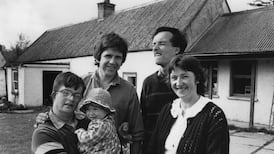Most people are probably only vaguely aware of Aosdána, even though the State-funded artists’ organisation is more than 30 years old. That’s partly because its 247 members meet just once a year, at a day-long general assembly. The afternoon session is open to all, but no member of the public has attended one when this reporter has been there.
Aosdána was established in 1981 by the late Charles Haughey, as an organisation of Irish-based artists, some of whom would receive a State-funded stipend. Haughey’s cultural adviser Anthony Cronin, who became a founding member of Aosdána, is credited with the idea of creating an Irish equivalent of the Académie Française. Cronin told this newspaper in 1981 that aosdána “was the old Irish name of the filíochta for men of wisdom . . . I think this tie-up with the Gaelic tradition appealed to the taoiseach very much.”
In 1983 Haughey’s successor Garret FitzGerald formally addressed the first assembly of Aosdána. The organisation was to consist of 150 artists, nominated and elected by their peers. Those who earned less than a certain amount were to be entitled to the cnuas, as the stipend is known; at that time the payment was £4,000 a year.
0 of 3
Since then Aosdána’s membership has risen by 100. One of its highest-profile members at present is the writer Margaretta D’Arcy, who is serving a three-month sentence in Limerick Prison for protesting against the use of Shannon Airport by the US military. Membership is for life, so in recent years the few much sought-after places that have become vacant have usually done so because of a death. Currently, 155 members receive the cnuas, which is now €17,180, and is tax free.
Members of Aosdána can also “join the artists’ pension scheme if they so wish”, according to the Arts Council, through which the State funds the organisation. “In all cases the Arts Council pays half of the premium. In the case of cnuas recipients, the member’s contribution will be deducted from the cnuas.” Last year Aosdána received almost €2.7 million from the Arts Council. It spent nearly all of it on the stipend.
What does it do?
More than three decades on from its establishment, what does Aosdána look like now? What does it do? And to whom is it accountable?
Few Irish arts organisations get such substantial funding. The Abbey Theatre received €6.5 million for 2014, the highest payment to a single organisation. Wexford Festival Opera received the second-highest amount, €1.4 million. Since 2007 nearly every arts organisation has had to contend with cuts in State funding. The cnuas has never been cut.
Aosdána regulates itself, through the toscaireacht, a committee of 10 members elected from within the organisation. They meet at least three times a year. The current toscairí are Cronin, the composers Seóirse Bodley and Jane O’Leary, the poets Theo Dorgan and Mary O’Malley, the architect Shelley McNamara, the novelist Colm Tóibín and the artists Mary FitzGerald, Alice Hanratty and Brian Maguire, the last of whom is the committee’s chairman.
Aosdána’s web pages, which are part of the Arts Council site, list all of the organisation’s members and include minutes of 50 toscaireacht meetings since 2003. Until last month the most recently listed were from February 2013; now they also include minutes from last July. November’s have yet to be posted.
How does Maguire, who has just been appointed to the Arts Council, think people view Aosdána? “I haven’t a clue,” he says initially, before thinking and adding, “Very warmly. Just look at the huge reaction to the death of one of our former members, Seamus Heaney.”
He says that Aosdána is unique, and that it brought together “two seemingly contradictory elements”: honouring achievement and helping artists off the breadline. “When Aosdána was set up there were very senior artists who were living in poverty.” The cnuas now guarantees members a modest income.
“We meet once a year. We have a short afternoon of discussion. That’s the only time we exist as a body. The rest of the year we are individuals working on our own. The big regulation is that you have to work, and be full time at it, in order to be eligible to receive the cnuas.”
Maguire wants to address any perception that Aosdána is elite and therefore unfair. “We have elite academies for our sportsmen, and everybody’s comfortable about that: the word ‘elite’ is seen as a positive there. We’re supposed to be elite,” he says. “We’re supposed to have the best of every discipline in Aosdána. I do have a problem with the word ‘exclusive’, though. For a group to be exclusive it has to exclude an awful lot of people, in order to maintain the exclusive quality. But Aosdána has a large membership.”
Poor attendance
The annual general assembly is where new members are elected, in the private morning session. Members who cannot attend are meant to vote by post. The minutes of toscaireacht meetings over the years consistently refer to poor attendance, despite meetings being flagged between two and four months in advance.
In 2013, attendance was recorded as 126, up marginally from 125 in 2012 and, more significantly, from 110 in 2011. This means just half of members are turning up for their one annual commitment. “By definition we’re an elderly group,” says Maguire. “Some people might be ill. Attendance is usually about 50 per cent. That figure probably stands in comparison to other groups in society, any membership group. We’d all like the attendance and return of postal ballots to be 100 per cent, but think about turnout in national elections. It’s about the same. This is an average level of participation in elections across society.” Maguire says about 20 per cent of members who don’t attend return their postal ballot.
Every member of Aosdána was elected by his or her peers. Yet, ironically, by neither attending the general assembly nor voting by post, almost half of them are failing to help other artists to follow in their footsteps.
For the general assembly to consider admitting a new member, the candidate must first have been voted for by more than half of the current members of his or her prospective artistic grouping within Aosdána. (These are visual arts, literature, music, architecture and choreography.)
In an effort to raise voting numbers, to reach the quorum, the minutes of July 2013 state that, in these “discipline ballots”, a blank ballot will be counted as a vote. Maguire says this means that each nominee then receives a vote. In local and national elections this would register as a spoilt vote.
In the March 2011 minutes the toscaireacht noted “that in coming years there would be far fewer places available”. It saw this as positive: “Having a large number (say 20-30 artists) competing for two or three places at a general assembly would be a good thing.” The same set of minutes also noted, in seeming contradiction, that it is “disheartening and difficult for artists that have been nominated several years in a row to be continually rejected by their peers”.
Bigger cnuas
In 2007 Aosdána sought to increase the cnuas to €20,000. One of the toscairí raised the issue with Mary Cloake, the then director of the Arts Council. The organisation also asked for the cnuas to be "index-linked so as to avoid the need for Aosdána to be returning to the Arts Council in subsequent years seeking further increases". The member of the toscaireacht put it to Cloake that "if the cnuas should continue to lose value Aosdána would lose a great part of its meaning".
If financial support is indeed at the heart of Aosdána’s role, it might be worth asking whether the organisation should include any artist who can make a living without the stipend. By continuing as members, they in effect prevent the election of artists whom the cnuas could greatly benefit. (If every member needed the stipend, it would cost Aosdána an additional €1.6 million a year.)
In the event, neither proposal was acted on, and at the same meeting Cloake asked the committee “whether members would be open to considering new ways of engaging with the public as part of their membership of Aosdána”.
This is a regular feature of the minutes: the Arts Council’s apparent desire for Aosdána to be more accessible and accountable to the public and to be an advocacy body for the arts. Cloake’s request on that occasion was rejected, as “most artists consider their work to be their primary point of contact with the wider world”.
In July 2012 it was again noted in minutes that the Arts Council “had asked Aosdána to consider the role it might play as an advocate for the arts”. None of the subsequent minutes addresses this request.
“We did go back to the Arts Council about that,” Maguire says. “We said Aosdána is a collection of individuals who make art. The work that they create is the best advocacy for the arts.”
In his address to the inaugural gathering of Aosdána, on April 14th, 1983, Garret FitzGerald said the organisation should “avoid the creation or perpetuation of cliques, whose existence is an unhappy feature of some of the arts in Ireland as in other countries”. FitzGerald also told the assembly that “you will concern yourselves with increasing the accessibility of art to the people and ensuring the gap does not grow”.
When The Irish Times asked the Arts Council if Aosdána could better engage with the public, it pointed out that "Aosdána is an affiliation of artists, not a representative body. However, many members of Aosdána regularly comment on and advocate for the arts, further underscoring through their work and their public profile the value of the arts to our society . . . The Arts Council is indeed grateful to artists, arts organisations and all others who assist us in this regard."
The question is whether this gratitude is worth €2.68 million in annual funding.
Artistic ambitions: Aosdána's mission, and how it works
What is Aosdána? An organisation that aims to "honour artists whose work has made an outstanding contribution to the arts in Ireland, and to encourage and assist members in devoting their energies fully to their art".
When was it established? 1981.
How many members are there? Currently 247. The cap is 250.
What is a cnuas? An annual stipend of €17,180, paid to members whose income is less than €25,770, averaged over three years. If an artist's income exceeds this, the cnuas is suspended until his or her income drops back below the threshold. Under new rules, artists will have to provide tax-clearance certificates to receive the cnuas.
How many members currently receive the cnuas? 155.
Who funds Aosdána? The Arts Council.
How do you join? With difficulty, via peer nomination and election. Many more artists apply than there are places. There are currently only three vacancies across all disciplines for the 2014 elections.
How much did Aosdána cost the State in 2013? €2.68 million.
















